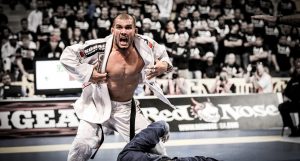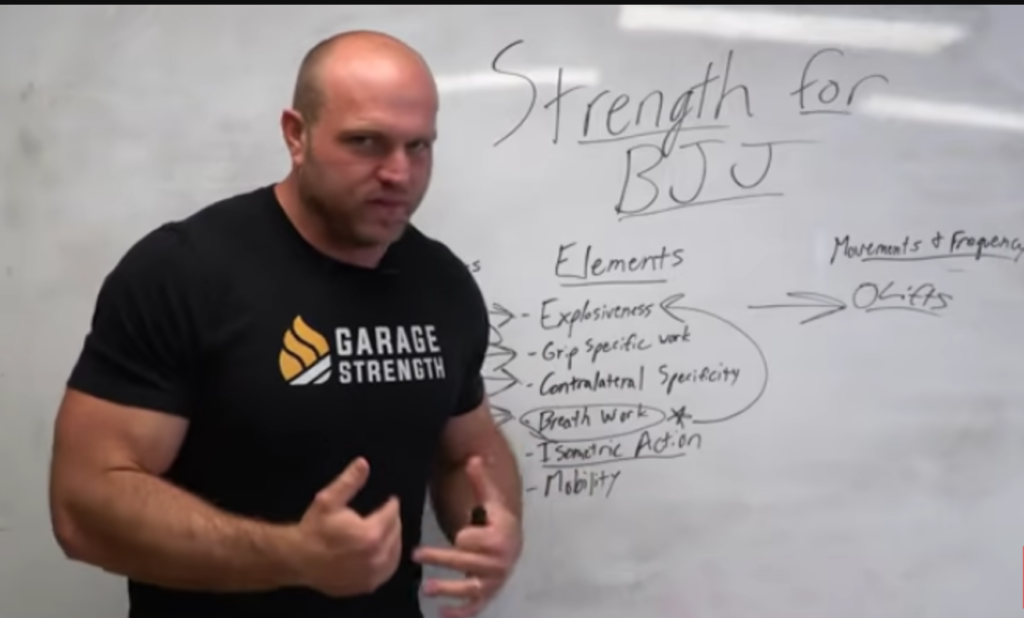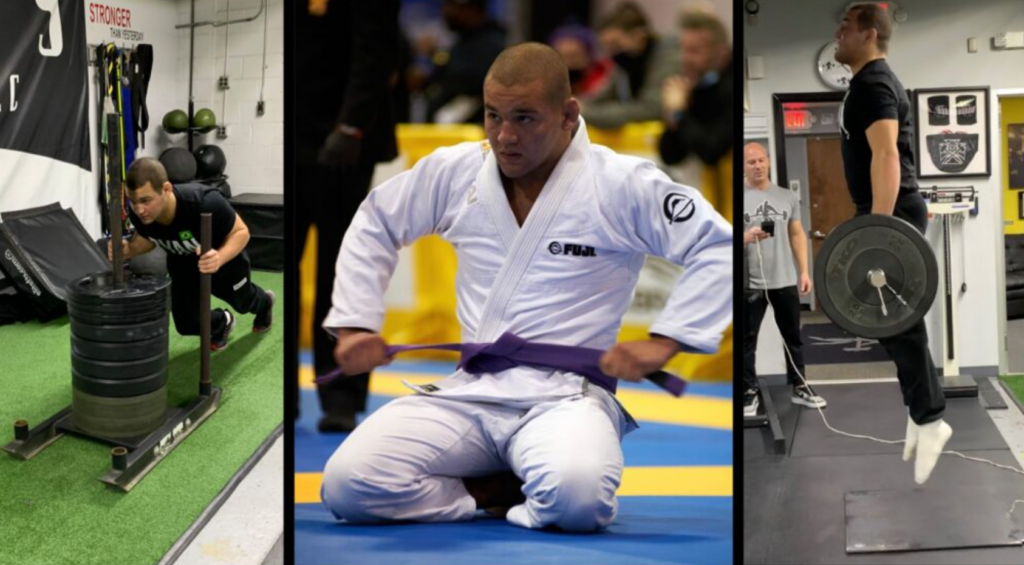
BJJ competition preparation is not an easy endeavor. First and foremost, you have to have a solid technical base before even thinking about competitively stepping on the mats.
Second, going in without a defined game plan based on your technical strength is a must. You also have to be smart about choosing your weight class, because weight cuts can be a real nuisance and can greatly hinder performance. And lastly, you have to be in good physical shape to be able to go through all the matches.
What I mean by good physical shape is that you need a solid level of strength as well as a good gas tank in order to compete. There are instances in which technique can only take you so far before strength becomes the deciding factor.
At white and blue belt levels, when the technique is not that sharp anyway, a lot of the match outcomes depend on the physical state of the competitors involved. Even at the elite black belt level, when two competitors are very closely matching in terms of technique, strength, and conditioning is often the edge that decides the match.
The Benefits of Strength and Conditioning for BJJ
So even for the average Joe who only trains BJJ a few days a week, a solid strength and conditioning plan is a great idea. Regardless of competition aspirations, supplementing BJJ with physical training has multiple benefits.
A very important aspect of strength training is the improvement of the range of motion for your joints. As far as joint abuse goes, BJJ is high on the list of sports that take their toll. Keeping your joints healthy and strong can prolong your BJJ journey for a significant amount of time.
Also, the tendon strength that you develop through strength training means that you’ll be less prone to training injuries. Of course, there is the obvious benefit of being stronger and more powerful on the mats.
Conditioning, on the other hand, is training for endurance and developing the ability to last longer at a higher pace when rolling. What conditioning offers is the ability to perform with consistent intensity throughout the whole competition.
Obviously, this is the ideal state and is practically impossible, but you can keep your performance level high if you’re well-conditioned. Being able to relentlessly go for submissions for the entire duration of the match offers a huge advantage over the opposition.
Structuring a Supplemental Training Plan
Let’s look at the scenario of a professional athlete preparing for a grappling competition. They train 7 out 7 days a week, juggling high and low-intensity sessions on the mat (tough sparring, perfecting technique, game plan drilling).
On top of that, he has the weekly meal prep crucial for keeping energy levels high while not gaining weight. Since sleep is a major factor in successful recovery, they manage to get their 8 hours a day in. Seems like a handful already without mentioning strength and conditioning training thus far.
In another scenario, we have a recreational athlete, with a 9-5 job and a heap of family obligations who has decided to compete for the first time. They manage to maintain a reasonable eating plan and get on the mats 3-4 times a week. Every time they get close to 6 hours of sleep at night is worth celebrating.
So, how does our regular Joe figure out a way to fit in a strength and conditioning plan that will help them improve physically, but not kill them in the process? We already established that training strength and conditioning is an essential piece of the competition puzzle.
With this in mind, it’s important how you structure the supplemental training in order to help your Jiu-Jitsu instead of diminishing it:
1. Frequency
To start let’s look at the frequency of training. As stated above, training strength and conditioning should help get you stronger and better, not tire you out. For both professional and recreational athletes, a scheduled rest day is the starting point.
From there, recovery abilities, goals, and time constraints dictate the frequency of strength and conditioning training. Going for 1-3 supplemental training sessions a week is a reasonable range in which all levels of athletes can find the option that best suits them.
Going for more than 3 sessions will most likely have a negative return, but if you really must train harder, then look to up the intensity of the sessions instead of the frequency.
2. Intensity
Which brings us to intensity. Going all out, leaving a sweat angel on the ground, and puking your guts out epitomizes the wrong approach. How tired you are after a training session is in no way an indicator of the productivity of the session.
Your ability to recover will dictate the intensity more than anything. If you’re to beat up in BJJ training the next day, then why do 1 RM squats the day before? One maximum-effort training session might derail your whole week and in the long term lead to over-training.
3. Active Recovery
A subject that we’ll cover in detail in another article, active recovery should be done daily. Yes, that includes your rest day as well, and you might even use it to take it up a notch. During a rest day, do light yoga, walk, hike, take the dog for a walk, or just move around.
On training days, finish the day off with some foam rolling, stretching, contrast showers, or easy stretches. And go for a message. At least once a month go for a message to give your muscles relief.
Strength or Conditioning First?
Now that structure has been mapped out, and goals have been set, it’s time to decide which quality you want to develop further. There are a couple of indicators that should be the main guides when making this choice.
Fitness levels are the primary determinant in choosing which area you need to focus on the most. A good fitness test can very precisely show what your main weakness is. I recommend that you work with a certified coach for both the test and the actual training itself. You can’t learn BJJ from books and video clips only and strength training is no different.
In addition to the fitness test, the time you have until match day is the second major factor for your supplemental training. There’s no point in starting a program if you’ve got a match in three weeks because you’re only going to tire yourself out. If you’re in a position like this, just stick to BJJ and go out and do your best. Next time around allow yourself more time to prepare.
Focus on Your Weakness
In short, let’s say you have 12 weeks until the competition of your choice. You’ve been running because that’s what Rocky did and you’ve been putting in hours on the mat. A fitness test shows that your conditioning is not at the desired level but not bad overall.
Your strength, however, is far below standards. I’m going to devote a full future article to strength standards for grappling athletes, but for now, let’s just agree that you suck at being strong.
Since conditioning takes less time to develop, and you already have a decent gas tank, strength should be the main focus. A couple of sessions a week, with a carefully planned prioritization, will definitely improve your strength over an 8-week cycle.
Having 4 more weeks left means you can devote 3 weeks to developing energy systems so that you have the gas tank to match. The last week is a recovery week, where you need to peak for the tournament so that one won’t count.
It’s not rocket science. The rule of thumb is that when in doubt, go for strength. Strength will supercharge your athletic abilities and give you confidence. Add in properly structured conditioning and you’ve done all you can to make sure you get your hand raised.
Final Thoughts
So, short of getting on roids, you now know exactly what it takes to develop strength and conditioning just like any elite-level grappler – time management and dedication. It is more difficult than it sounds, though!
Remember that simply training a lot, even if it is structured to your specific needs is not enough. You also need to factor in rest, recovery, a proper eating plan, the demands of eight cutting, and BJJ training in there.
For those who are also juggling a family and full-time job, I have some good news and some bad news. The good news is that you can pull it all off, and see great results with this approach. The bad news is that you can’t keep it up for long, so you better see it as e period of a couple of years where you can have your fun, rather than something you can keep on doing.
Related Articles:
George Lockhart Nutrition and Weight System – Mcgregors Personal Nutrition Coach
The Perfect Strength And Conditioning Workout For BJJ by T. Stevens
10 Strength and Condition Bodyweight Exercises for Jiu-Jitsu – Tutorial
Bear Crawl Yourself Into Shape For Brazilian Jiu-Jitsu
How To Develop Crushing Grip Strength For BJJ
Travis Stevens’ 3 weeks / 3x per Week Weight Lifting Program for Grapplers
The Best Strength & Conditioning DVD and Digital Instructionals
10 Strength and Condition Bodyweight Exercises for Jiu Jitsu – Tutorial


![Darce Choke Encyclopedia – Origins, Mechanics and Variations [2025] BJJ, choke, Brabo, BJJ Darce Choke, D'arce Choke, Darce BJJ Choke](https://bjj-world.com/wp-content/uploads/2017/11/JungPoirierLeeYahoo-218x150.jpg)














![Slicin’ Calves Mikey Musumeci DVD Review [2025] Slicin' Calves Mikey Musumeci DVD Review](https://bjj-world.com/wp-content/uploads/2025/04/slicin-calves-mikey-musumeci-dvd-review-218x150.png)
![Jiu-Jitsu For Old Guys Guard Retention Bernardo Faria DVD Review [2025] Jiu-Jitsu For Old Guys Guard Retention Bernardo Faria DVD Review](https://bjj-world.com/wp-content/uploads/2025/03/old-guys-guard-retention-bernardo-faria-dvd-review-218x150.png)
![X-Guard Trickery Kyle Sleeman DVD Review [2025] X-Guard Trickery Kyle Sleeman DVD Review](https://bjj-world.com/wp-content/uploads/2025/03/x-guard-trickery-kyle-sleeman-dvd-review-218x150.png)
![Countering with Crab Ride Anthony Budion DVD Review [2025] Countering with Crab Ride Anthony Budion DVD Review](https://bjj-world.com/wp-content/uploads/2025/03/countering-with-crab-ride-anthony-budion-dvd-review-218x150.png)
![Closet Closed Guard Craig Jones DVD Review [2025] Closet Closed Guard Craig Jones DVD Review](https://bjj-world.com/wp-content/uploads/2025/03/closet-closed-guard-craig-jones-dvd-review-218x150.png)
![Mastering The Crucifix Alexandre Pereira DVD Review [2025] Mastering The Crucifix Alexandre Pereira DVD Review](https://bjj-world.com/wp-content/uploads/2025/01/mastering-the-crucifix-alexandre-pereira-dvd-review-324x235.png)
![Weight Training For Grappling Michael Israetel DVD Review [2025] Weight Training For Grappling Michael Israetel DVD Review](https://bjj-world.com/wp-content/uploads/2025/01/weight-training-for-grappling-michael-israetel-dvd-review-100x70.png)
![Ginastica Natural Alvaro Romano DVD Review [2024] Ginastica Natural Alvaro Romano DVD Review](https://bjj-world.com/wp-content/uploads/2024/12/ginastica-natural-alvaro-romano-dvd-review-100x70.png)

![Mastering Control From Top Position Trent Hidlay DVD Review [2024] Mastering Control From Top Position Trent Hidlay DVD Review](https://bjj-world.com/wp-content/uploads/2024/11/control-from-top-position-trent-hidlay-dvd-review-100x70.png)
![Gracie Secrets Closed Guard Kyra Gracie DVD Review [2024] Gracie Secrets Closed Guard Kyra Gracie DVD Review](https://bjj-world.com/wp-content/uploads/2024/12/closed-guard-kyra-gracie-dvd-review-100x70.png)
![Slay The Wrestle Up Guard Nick Rodriguez DVD Review [2024] Slay The Wrestle Up Guard Nick Rodriguez DVD Review](https://bjj-world.com/wp-content/uploads/2024/12/slay-the-wrestle-up-guard-nick-rodriguez-dvd-review-100x70.png)

![Knee Lever John Wayne Sweep Adam Wardzinski DVD Review [2024] Knee Lever John Wayne Sweep Adam Wardzinski DVD Review](https://bjj-world.com/wp-content/uploads/2024/12/john-wayne-sweep-adam-wardzinski-dvd-review-100x70.png)
![Baby Shark Guard System Diogo Reis DVD Review [2025] Baby Shark Guard System Diogo Reis DVD Review](https://bjj-world.com/wp-content/uploads/2025/02/baby-shark-guard-system-diogo-reis-dvd-review-100x70.png)


![Countering Triangles And Omoplatas Adam Mazin DVD Review [2024] Countering Triangles And Omoplatas Adam Mazin DVD Review](https://bjj-world.com/wp-content/uploads/2024/10/countering-triangles-and-omoplatas-adam-mazin-dvd-REVIEW-100x70.png)



![Leg Lock Stock And Barrel Taylor Pearman DVD Review [2025] Leg Lock Stock And Barrel Taylor Pearman DVD Review](https://bjj-world.com/wp-content/uploads/2025/03/leg-lock-stock-and-barrel-taylor-pearman-dvd-review-100x70.png)



![EMU Guard 2.0 Benjamin Power DVD Review [2024] EMU Guard 2.0 Benjamin Power DVD Review](https://bjj-world.com/wp-content/uploads/2024/11/emu-guard-2-0-benjamin-power-dvd-review-100x70.png)
![Collar Sleeve Guard Mikey Musumeci DVD Review [2024] Collar Sleeve Guard Mikey Musumeci DVD Review](https://bjj-world.com/wp-content/uploads/2024/12/collar-sleeve-guard-mikey-musumeci-dvd-review-100x70.png)


![Jett Thompson Master Ankle and Aoki Lock DVD Review [2024] Jett Thompson Master Ankle and Aoki Lock DVD Review](https://bjj-world.com/wp-content/uploads/2024/09/jett-thompson-master-ankle-and-aoki-lock-dvd-review-100x70.png)
